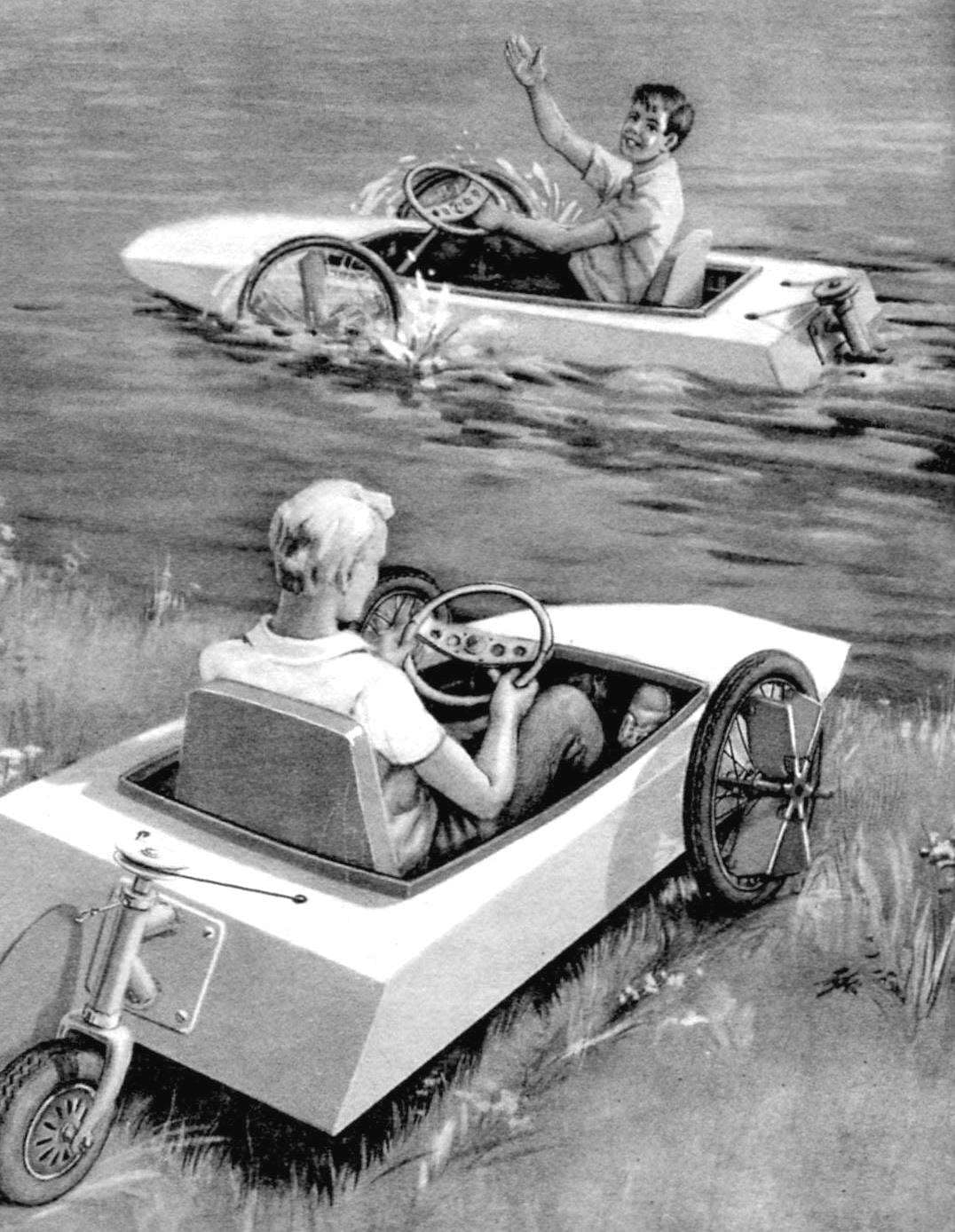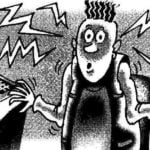 Diverse and numerous family water bikes, but they all have a major flaw: transport them by land very difficult. Another thing – “ampipe”, on land he feels as confident as on the water. The secret to this versatility in the propeller – crankshaft with propeller wheels when traveling on the roads is the leading “front axle”.
Diverse and numerous family water bikes, but they all have a major flaw: transport them by land very difficult. Another thing – “ampipe”, on land he feels as confident as on the water. The secret to this versatility in the propeller – crankshaft with propeller wheels when traveling on the roads is the leading “front axle”.
To make a “ampipe” not so difficult. Start the work with the frame of the boat. Frames glue from pine slats with a cross section 35×15 mm, reinforce the joints with plywood gussets and screws. Transom Board cut from a sheet of plywood with a thickness of 12-15 mm., Its size is 900 mm. х220 For longitudinal set of case prepare four strips with cross-section 20×20 mm, two – section 35×15 mm and one 35×35 mm. the Length of each rail – 2000 mm. For the keel will also need a strap 1330x35x15 mm.
A few days before assembling the frame, the blank for the keel beam (cross-section 35×35 mm) should be soaked in water (for two days), and then placed on the berth – Board with a thickness of about 40 mm., the deflection of the beam must match the configuration of the bottom. After drying for two to three days, the workpiece is mounted on a flat horizontal surface and secured with small nails. Colored pencil or marker mark the location of frames and in designated areas penetrate the grooves. Install the keel beam elements of the transverse set and temporarily secure them on it. Next, in the corners of the frames and transom boards, make the grooves for the slats in the longitudinal set.

Three-wheeled amphibious:
1 – swivel; 2 – seat; 3 – the steering wheel; 4 – sprocket; 5 – housing; 6 – crankshaft; 7 – starcrazy; 8 – steering drum

Steering gear:
1 – steering wheel; 2 – steering shaft; 3 – pin with washer; 4 – a bracket, steering bearing (steel s3); 5 – the Central bearing; 6 – bearing; 7 – keel beams; 8 – hull bottom
The frame is assembled using polyvinyl acetate, or casein glue and screws. During Assembly carefully check relative positioning of elements of longitudinal and transverse sets of straight out. Other longitudinal elements of the set are adjusted at the place, that is, the rail is applied to the frames, to indicate its position on them, and then cut the slots.
After Stripping frame, panel it with plywood or hardboard. Start with the bottoms. Attach the workpiece (2000x1000x4 mm), draw the frame with an allowance of 3 – 5 mm on the side and cut it off. Then lubricate the mating surface with glue, put the trim on the frame and the transom, nails with a length of about 20 mm nail it to the details of the set. When the glue is dry, carefully apply a plane the contours of the sheet.
Similarly, the side panel and deck. The joints carefully apply zarovnaya outside and inside with epoxy putty. External contours it is useful to additionally cover the boat fabric in a single layer. You can glue it with any resin, including parquet lacquer as well as paint grades GF and PF.
Now take up rowing mechanism. It includes the crankshaft, bent from steel rod with diameter 12 – 14 mm, two bike wheels (we recommend to use the front wheels of bicycles), and two paddle wheels collected from six plywood (10 mm thick) or aluminum (3 mm thick) plates each. The dimensions of the rowing plate 250×150 mm. Mount it to the wheel rim is made by duralumin corners and countersunk screws. In the center of the rowing plate is collected through a notched plate made of aluminum with a thickness of 2 mm.
Bearing crankshaft clip on trapezoidal wooden bar thickness of 35 mm, lined on both sides chetyrehkilometrovoy plywood. To the bar the same screw bearing, steering column steel bracket with holes, bent from strips with a thickness of 4 mm. Steering column, dural tube in diameter 20 – 22 mm – lock in the bearing with two cotter pins.
The steering wheel is desirable to use ready, but you can make your own by bending it out of aluminum pipe with a diameter of about 20 mm, or use the ring from the old Vienna chair. The spoke bagels cut of duralumin sheet thickness of about 3 mm. Central sleeve carved on a lathe, or pick the perfect bar.

Device front axle:
1 – wheel (off the bike); 2 the deck; 3 – piping cockpit cushions; 4 – pedal (plywood or PCB); 5 – center support bearing (brass or copper s2); 6 – crankshaft (steel Ø12-14); 7-mounting bracket of the propeller blades (dural area 20×20); 8 – row plate (plywood or aluminum s10 s3); 9 – decorative plate; 10-strengthening of Board (plywood s12); 11 – bearing-bushing (brass, bronze); 12 – keel beams; 13 – the support of the Central and steering bearing; 14,15-longitudinal set of case

Case equiped amphibious
Rear driven wheel (from a child’s Bicycle or stroller) is fixed on the swing arm, welded from the front of the old bike frames and steel plate. On the transom Board it is secured with four bolts. The steering drum is a round wooden boss with a diameter of 100 mm, with two dural cheeks.
To control the “Amphipoda” on the water provided a dural steering pen, pivotally hinged to the axis of the rear wheel. Before leaving the machine to land the pen is raised and secured with rope with a carabiner.
For posting startrow will need four to six blocks: are there any children’s designer. To adjust the tension of the ropes can be a couple of turnbuckles (turnbuckles).
Seat, “Amphipoda” is a wooden frame covered with nylon cord or vinyl chloride tube with a diameter of 5-6 mm. When the installation seat in the hull of the boat provide the ability to adjust its position depending on the height of the driver.
After finishing the Assembly work, prosopalgia body inside and outside and paint two or three layers enamel GF or PF. That’s all. It remains to test the amphibious as in the land and water option, recheck all joints and bearings, to eliminate a possible leak.
I. EVSTRATOV



